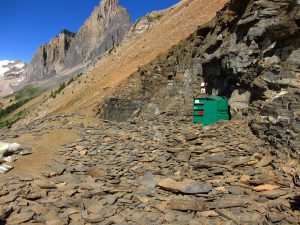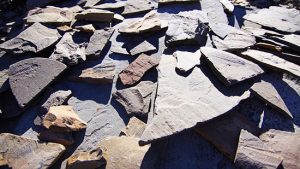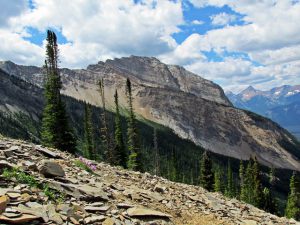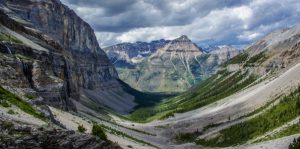

Mt. Stephen Fossil Beds (all spots filled)
Made famous by the early exploration and collection of fossils by Charles Doolittle Walcott, the Walcott quarry sits on the shoulder of Mt. Walcott in Yoho National Park. Across the valley from the Burgess Shale, lies the Mt. Stephen fossil beds - an excellent collection of Cambrian trace and body fossils, most notable for its well-preserved trilobites. Neither of these localities are accessible without escort by a licensed guide, as they are protected UNESCO world heritage sites. We are currently working with Parks Canada to arrange a field trip to the Mt. Stephen Fossil Beds (~$85 CAD/person – payment details forthcoming) for Sunday June 11th, before the conference begins. Due to group size restrictions at the sites, we are only able to offer 50-60 spots. For those interested in attending please email geobiology2017@gmail.com as soon as possible, and depending on interest we may have to utilize a draw if necessary.
This field trip will depart from the meeting place in Banff (TBD) at precisely 6:00 AM on Sunday June 11th, 2017 to meet the guides from Parks Canada at the visitor center in Yoho National Park by 7:00 AM, and will return to Banff at approximately 5:30 PM. For those confirmed as attending please arrive in Banff by Saturday June 10th, 2017.
Note: Trail conditions (i.e., rocks, ice, and mud) may be in early season conditions, and conditions can change quickly in the mountains. Please come prepared if you are attending the field trip or are planning on doing any hiking before or after the conference. For more information on the Burgess Shale and Mt. Stephen Fossil Bed Hikes see:http://www.pc.qc.ca/eng/pn-np/bc/yoho/activ/burgess.aspx

Mt. Stephen
Prime hiking season in Banff, Yoho, and Kootenay National Parks is generally from early July until mid-September. Although trails in the valley bottoms may be in excellent condition in June, alpine trails such as the Burgess Shale, Mt. Stephen trilobite beds, and Stanley Glacier may be subject to early season conditions. Early season conditions may increase the difficulty of hikes or make trails impassible and can include: snow (and associated avalanche risks), snow melt, mud, and/or recent trail obstructions. Come prepared for potential early season conditions, as well as temperatures that can fluctuate between near freezing to upwards of 20ºC during the day, and between valley bottoms and alpine passes.
Other good photos for Mt. Stephen:
http://hikingwithbarry.com/2013/11/17/mount-stephen-trilobite-beds-field-hiking-bc


Stanley Glacier
The Stanley Glacier trailhead is located on highway 93, between Banff and Radium, about a 45-minute drive from the Banff Centre. The trail climbs approximately 450 m over 5 km (10 km round trip), and is across the valley from the recently discovered Marble Canyon quarry in Kootenay National Park. Parks Canada estimates that the hike takes approximately 7 hours to complete and rates the difficulty as moderate.
The forest at the outset of the hike is currently undergoing regeneration following a forest fire in 1968. The hike then crosses a river, and passes several waterfalls, before providing picturesque Stanley Glacier. Several types of fossils from the Eldon formation and Stanley Formation can be found at the base of Mt. Stanley, as the Stanley Formations which hosts the famous Burgess Shale fossils to the North West by Field, B.C., thins out in this area. The final stretch to the base of Mt. Stanley is a ~1 km climbs over rough trail and rocks. Please note, that as the hike lies within National Park boundary, the collection of fossils or other environmental artefacts is strictly prohibited.
The trip will occur in late spring, a time during which the Canadian Rockies can experience a wide variety of weather conditions – spanning from summer temperatures to cool weather with high winds, and even snow – so please come prepared for a variety of conditions.
The field trip leader, Dr. Murray Gingras from the University of Alberta an Ichnologist Extraordinaire, will provide a brief overview of the general stratigraphy of the area and the Canadian Rockies in general. Emphasis will be placed on the depositional environment and its implications for early the proliferation of Cambrian life. Additionally, Dr. Gingras is ideally suited to comment on the trace fossils, such as feeding structures, that have been previously identified at the apex of the hike.
